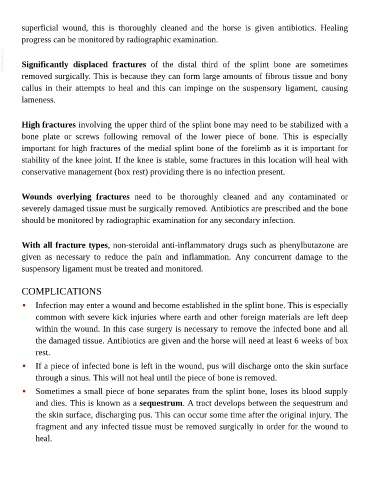Page 457 - The Veterinary Care of the Horse
P. 457
superficial wound, this is thoroughly cleaned and the horse is given antibiotics. Healing
progress can be monitored by radiographic examination.
VetBooks.ir Significantly displaced fractures of the distal third of the splint bone are sometimes
removed surgically. This is because they can form large amounts of fibrous tissue and bony
callus in their attempts to heal and this can impinge on the suspensory ligament, causing
lameness.
High fractures involving the upper third of the splint bone may need to be stabilized with a
bone plate or screws following removal of the lower piece of bone. This is especially
important for high fractures of the medial splint bone of the forelimb as it is important for
stability of the knee joint. If the knee is stable, some fractures in this location will heal with
conservative management (box rest) providing there is no infection present.
Wounds overlying fractures need to be thoroughly cleaned and any contaminated or
severely damaged tissue must be surgically removed. Antibiotics are prescribed and the bone
should be monitored by radiographic examination for any secondary infection.
With all fracture types, non-steroidal anti-inflammatory drugs such as phenylbutazone are
given as necessary to reduce the pain and inflammation. Any concurrent damage to the
suspensory ligament must be treated and monitored.
COMPLICATIONS
• Infection may enter a wound and become established in the splint bone. This is especially
common with severe kick injuries where earth and other foreign materials are left deep
within the wound. In this case surgery is necessary to remove the infected bone and all
the damaged tissue. Antibiotics are given and the horse will need at least 6 weeks of box
rest.
• If a piece of infected bone is left in the wound, pus will discharge onto the skin surface
through a sinus. This will not heal until the piece of bone is removed.
• Sometimes a small piece of bone separates from the splint bone, loses its blood supply
and dies. This is known as a sequestrum. A tract develops between the sequestrum and
the skin surface, discharging pus. This can occur some time after the original injury. The
fragment and any infected tissue must be removed surgically in order for the wound to
heal.

